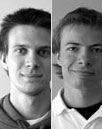Teaching Partial Differential Equations Using Mathematica
with Katarina Jegdic
University of Houston-Downtown
We present an overview of an advanced undergraduate mathematics course on partial differential equations where students are given an opportunity to generate and discover rather than to passively receive knowledge. The course material is motivated through projects that involve "real-world" applications where students use technology to solve various problems. We consider several projects: oil flow recovery, aerodynamics, and heat/wave equations. Each project consists of: (a) derivation of differential equations that describe the particular phenomena, (2) mathematical analysis of the problem and development of a numerical method for approximate solving, (3) implementation of the method using various computer algebra systems, and (4) writing a summary of research findings and/or presenting the findings in the class. Students are given a complete set of notes, consisting of book chapters, research papers, and instructor's notes on mathematical formulation of the problem and development of appropriate numerical methods. The instructor also provides a bone structure of the numerical code that students need to modify, incorporating various partial differential equations and initial conditions.
The proposal on introducing real-world projects and technology in courses on differential equations was developed in the fall of 2007, and its implementation was funded by the Curriculum Development Grant at University of Houston-Downtown in the spring of 2008. The projects were implemented in spring 2009, fall 2009, and spring 2011.
























